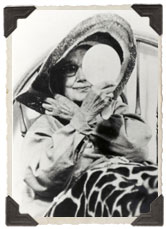About Big Edie
 Although her daughter Edie gets most of the attention and acclaim in the Grey Gardens documentary, those close to the family say that mother Edith was always the real talent and star of the “Beale” show.
Although her daughter Edie gets most of the attention and acclaim in the Grey Gardens documentary, those close to the family say that mother Edith was always the real talent and star of the “Beale” show.
Edith Ewing Bouvier was born October 5, 1895 in Nutley, New Jersey. Her father, “Major” John Vernou Bouvier, Jr., was a skillful New York attorney and later became a prominent judge. The family enjoyed all the trappings of elite social standing and wealth. According to Bouvier historian, John Davis, Edith was a difficult child – often mischievous, unruly, and disrespectful of authority (attributed to her “French genes”).

By the age of ten, Edith was already known for her artistic talent and was considered to be somewhat of a singer/pianist prodigy. Later, after the family moved from Nutley to New York, the now glamorous young lady found herself much in demand on the exciting social and party scene. Her father would always resent the “wasted” time she spent attending to her voice and appearance.
She would later marry one of her father’s future law partners, Phelan Beale, who was fourteen years her senior. The couple would have three children: Edith, Phelan, Jr., and Bouvier. The Bouvier’s spared no expense for their daughter’s nuptials; the elaborate ceremony was attended by hundreds at St. Patrick’s Cathedral in New York City.
As would have been expected, music played a prominent part in the ceremony. One of Edith’s demands for the wedding was a huge choir and a soprano solo (of which, she later admitted that she would have loved to have sung herself, had she not been at the altar!). An independent spirit, Edith would have a reputation for being theatrical, self-indulgent, and impractical.

In the early 1920’s Phelan and Edith purchased the Grey Gardens mansion located at the corner of Lily Pond Lane and West End Road in East Hampton, Long Island. It was at her new home that Edith would fully cultivate her bohemian ways. Utilizing her servants and staff, her daily routine included playing the piano, socializing with artists, and training her operatic mezzo-soprano voice. She pursued a professional singing career, hiring an accompanist and playing small venues and private parties. She would dress in an unconventional style that drew criticism from her fellow East Hampton elitists.
Her outlandish freethinking attitude and gypsy-like appearance embarrassed her husband. She reportedly refused to have her name printed in the Social Register. Edith could care less of the opinions of others, and she didn’t mind letting it be known.
 Phelan Beale left Edith in 1934 and moved to his hunting lodge. He later divorced her in 1946 by telegram from Mexico (Little Edie referred to it as a “fake Mexican divorce” because it was not recognized by the Catholic Church). Edith received child support, but no form of alimony. She kept Grey Gardens as part of the settlement and found the imposing home difficult to maintain on her own financially. Unable to support herself, her father would have to contribute upwards of $3,500 a year to assist her.
Phelan Beale left Edith in 1934 and moved to his hunting lodge. He later divorced her in 1946 by telegram from Mexico (Little Edie referred to it as a “fake Mexican divorce” because it was not recognized by the Catholic Church). Edith received child support, but no form of alimony. She kept Grey Gardens as part of the settlement and found the imposing home difficult to maintain on her own financially. Unable to support herself, her father would have to contribute upwards of $3,500 a year to assist her.
She would have a dramatic falling-out with her father in 1942 after the wedding of her son, Bouvier. She arrived to the nuptials twenty-five minutes late, dressed like an opera star. Utterly disgusted at Edith’s behavior, he changed his will two days later. Her inherited share of his $825,000 estate was now reduced to $65,000 and, as further insult, would be controlled in trust entirely by her sons. She would only receive $300 per month to support herself and her daughter. As a result, some guests that visited Grey Gardens were encouraged to “go shopping” while they were there. Little Edie sold Tiffany silver, jewelry, and other family valuables from under the safekeeping of her mattress.

Edith lived out the rest of her days behind the thick vines and decaying walls of Grey Gardens. After the raid (see “The House”), she would rarely leave the estate for fear that it might be taken from her. She died apparently from pneumonia on February 5, 1977 at the South Hampton Hospital. It is said that she told Little Edie on her deathbed that she had nothing else to say, because everything she wanted to tell the world was already in the Maysles documentary.
She is buried at the Bouvier family plot at the Most Holy Trinity Catholic Cemetery in East Hampton.

